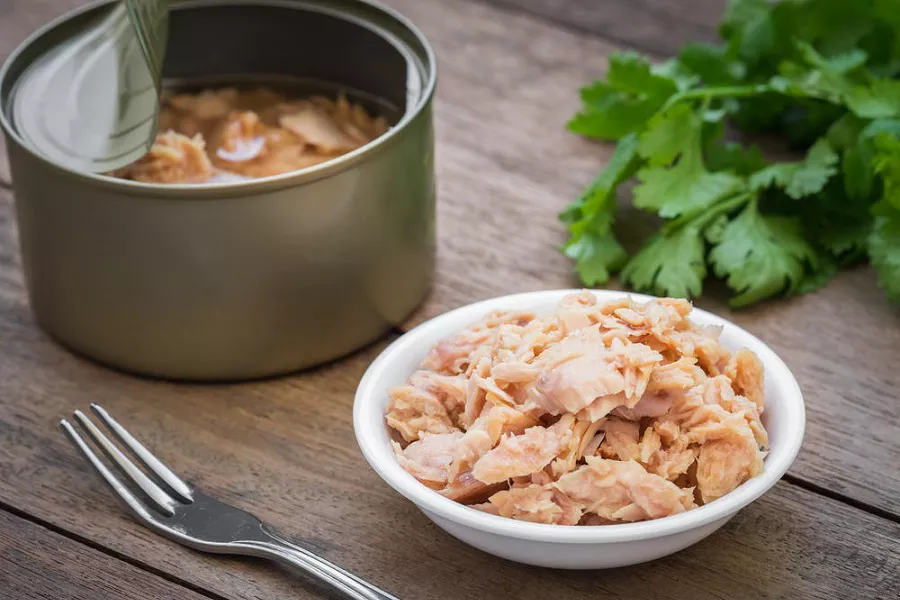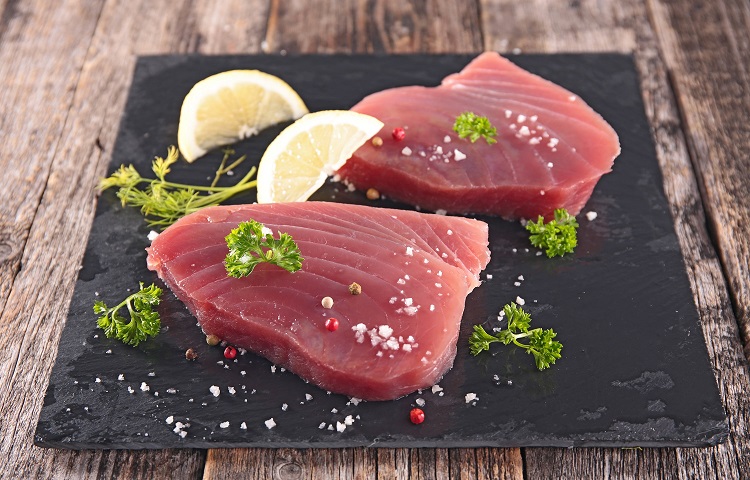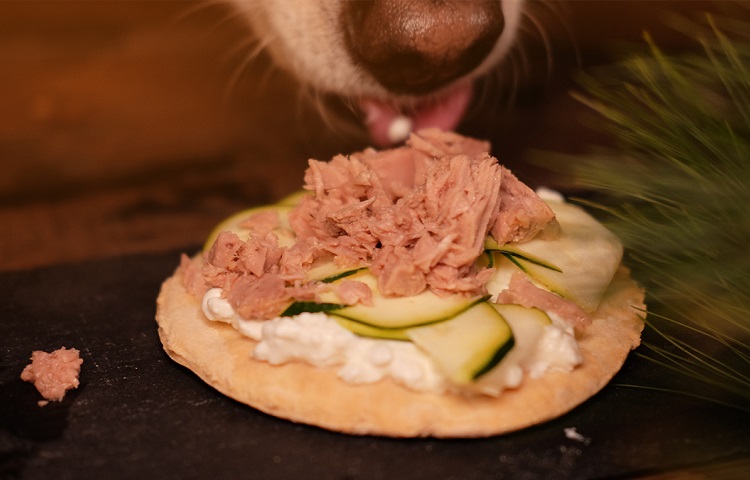Can My Dog Eat Canned Tuna

Contents of Article
If you are a pet owner, you probably already know that dog food contains fish because it is high in Omega-3 fatty acids and protein.
If you are a pet parent, you may be wondering what kind of fish can be served to your fur buddy. Besides protein, fishes are an excellent source of calcium, selenium, Vitamin B, and Omega-3 fatty acids.
To answer the question, “Can my dog eat canned tuna fish?”
The shorter answer is YES. Then comes the question of how much can be fed to your pet and in what form: Raw, Canned, or in the form of Dog food?
It would be best if you never fed raw Tuna to your dog. Fresh Tuna has a high level of mercury, and consuming too much of it can result in mercury poisoning. Compared to salmon or tilapia, fresh Tuna has a higher level of mercury. It can cause severe health complications in your dog. The mercury levels in Tuna are pretty high, so never feed raw Tuna to your dog.
If you have a feline pet at home, you need to keep a check on your dog, mainly if he is prone to stealing food from off the table. Wet cat food contains tuna, so you shouldn’t let your dog consume it under any circumstances.
If you want to serve fresh fish to your dogs, you need to turn to ones with lower mercury levels. Tuna fish is not only large; it lives long as well. So, it has a high concentration of mercury in its tissue. Since Tuna is high in protein, you need to be cautious and feed only small quantities of it at a time, or it may lead to mercury poisoning.
Because of coal-fired industrial activities, the mercury levels in the rivers and oceans increase more than ever. This mercury then gets accumulated in the fish. Larger fishes have a higher concentration of mercury in their tissues. And if the fishes have a longer life span, the mercury levels rise proportionally.
A pet dog is a treasured family member. Some dogs are fussy eaters, while others will gobble down whatever you give them. So, it is essential to know which foods and okay to feed your dogs and which ones are downright dangerous?
In this article, we have tried to answer some of your questions surrounding dogs eating tuna fish, as follows:
- What are The benefits of eating tuna for dogs?
- How much tuna should you be feeding your pet?
- What kind of tuna is best for them?
How much tuna can I give my dog?

First things first. What is Tuna? Tuna is a migratory saltwater fish. They belong to the mackerel family.
Sleek in shape and with a streamlined body, they can swim fast in the water. At 40 miles per hour, they are one of the fastest fish. Found in warm ocean waters, tuna are fished for human consumption.
The sizes vary tremendously. Tuna can grow anywhere from 1 to 15 feet. As far as weight is concerned, they can weigh well over 1500 pounds. Unfortunately, many varieties of tuna are on the verge of extinction. Did you know that some of the oldest tuna can reach up to half a century!?
Dogs are sure to love tuna! It is because most dogs love the taste of meat. The flavor of fish is something most dogs would find hard to resist.
You may want to give tuna to your fish because of its high protein content. Tuna is also found aplenty in commercial dog food. Tuna sandwiches, sushis, and casseroles are all super delicious, and so you may be tempted to share some with your pet companion. Especially when he comes sniffing around when you open a tin of tuna!
It is entirely safe to feed your pet dog one or two small bite-size pieces of tuna once or a couple of times a week. The quantity you should provide depends on the size of your pet. If you have a giant dog, his appetite will be more, and you can give him more. Smaller dogs require even more negligible.
Benefits of Tuna for my dog

Tuna can be a rich protein source (lean) for your dog. It is also rich in Omega 3 fatty acids, has anti-inflammatory properties, and improves your overall skin health.
Tuna also contains other healthy minerals like potassium, magnesium, phosphorus, and selenium. Selenium is good for the overall immune system of your dog. Also, it strengthens the joints.
It is rich in various vitamins like B3, B6, B12. The immune system of your dog becomes a whole lot stronger. The Omega-3 fatty acids also give your dog’s coat the healthy sheen you are looking for.
Apart from your dog gaining lean protein, it protects your furry buddy from gaining unwanted fat. Your dog’s eyesight gets better, and it also keeps the heart more healthy and vital. Furthermore, it helps in muscle growth. Tuna facilitates overall growth and development.
In theory, tuna is supposed to be super healthy for dogs as they are high in proteins, antioxidants, saturated fat levels and are loaded with vitamins, fatty acids, and minerals.
Is canned tuna safe for dogs?

There are 20 different types of Tuna fish, 5 of which can be consumed by dogs. These include yellowfin, skipjack, bigeye, bluefin, and albacore.
It can be served cooked, raw, or canned. Your pawed companion is sure to love tuna steaks which are as delicious as they are healthy.
It is ideal for giving them in small quantities a couple of times a week. Apart from the obvious culprits – Mercury poisoning and high Sodium content, the other reasons why tuna is a bit of a controversial treat for your fur buddy are parasites and contamination, Thiaminase and Vitamin B1, and the fact that some dogs may be allergic to tuna.
They are some varieties of tuna that are low in mercury levels. For instance, if you opt for either skipjack and albacore tuna, the chances that these will cause lead positioning if your dog consumes them is very minimal. You can also steep the tuna in water overnight before giving them to your dog.
What about lead?
Tuna is a variety of fish found aplenty in salt waters. The body of the tuna fish will absorb sodium. Sodium buildup will automatically lead to hypernatremia.
Hypernatremia is a condition caused by very high sodium levels. It can lead to serious illness. But worry not. A minor can of tuna fish will not cause any problems. Your dog will have to consume plenty of tuna fish over an extended period for it to become seriously ill.
How much tuna can I give my dog?
If you are going to feed your dog fresh Tuna, you can provide one or two tiny pieces of Tuna once or twice a week.
The weight of your dog determines how much Tuna they can eat.
If your dog is around 20 pounds and wants to feed canned Tuna, you can do so once every three weeks. If your dog is on the higher side, you can feed him a can of Tuna every nine days. If your dog is a heavy-weight at 90 pounds, it is safe to provide him a can of Tuna once in 5 days.
On average, a 6-ounce tuna tin contains 119 C. Save it as a special treat for your dog instead of giving Tuna as an everyday snack.
An average-sized sardine has around 25C, so if you have a Labrador at home, you can feed a sardine every day. If you have a smaller breed of under 20 pounds, provide no more than half a sardine per day.
Take it slowly. See how your pup reacts to tuna before you decide to give it to them regularly.
Should dogs eat tuna every day?

Dogs are way smaller than human beings. There are no specific recommendations of how much Tuna a dog can eat every day. Tuna is nontoxic, and a small amount will not lead to mercury poisoning or any health issues.
If your pet has a tuna preference, you can feed Tuna as an occasional treat. But not as an everyday staple. Tuna is a large variety of fish, but it also falls under warm-blooded fish.
Moreover, it is an apex predator right at the top of the food chain. This is great, but all heavy metals, lead, toxins, sodium, etc., get accumulated in the body because they eat the smaller fish swimming in the waters.
If Tuna is what your pet dog prefers, then this heavy metal buildup could lead to serious health issues. Once, or perhaps twice a week is wonderful! Anything beyond that is downright dangerous!
Note that if your dog is pregnant or lactating, limit the amount of fish she consumes if you are concerned about mercury or PCB contamination. Also, never give tuna if you have a tiny pup at home. During the first few years of life, your pup’s diet should be something that should be approved by the veterinarian when he conducts his regular examination.
If you notice Mercury poisoning symptoms, rush to the vet immediately.
Some of the symptoms of mercury poisoning include:
- Damage to the kidneys
- Anxiety, nervousness, and tremors.
- Hair Loss
- Vomiting blood.
- Watery diarrhea
Alternatively, high Sodium levels come with their symptoms include:
- Convulsions
- Lethargy and lack of appetite
- Nausea
- Swelling of the tongue
- Extreme thirst
Wrapping Up
If you want to feed fishes to your pawed buddy at home, choose one with lower mercury levels.
Tuna is high in protein, but that’s not the only good protein source. There are dog food brands in the supermarket with protein sources like lamb, poultry, and wild boar. Tuna is a natural source of protein. Some dogs, however, do not take well to poultry-based protein.
If you are looking for the best sources of protein to feed your fish, choose a type that is low in mercury. Salmon, whitefish, herring, flounder, and Arctic char are common types of fishes used in commercial dog food.
You can very well serve tuna in the form of steaks and bake or broil them if you want to cook them. Avoid all sorts of seasoning, salt included, and remove all the bones. Fishbones can make your dog choke. If you are not too fond of cooking, you can serve canned tuna packed in water, not oil.
Regardless of all the health benefits, tuna cannot be served as a regular food portion for your dog. And even when you do it, keep portion sizes to a minimum. The worst culprits are sodium and mercury. Sodium induces vomiting, seizure, and mercury, leading to slow poisoning and severe health conditions.
Give a small quantity first and watch out for any symptoms of allergy. It will be very much noticeable in the first 24 hours. So if you are going with tuna for your dog, go for ones with a short life without any seasoning or bones.
Canned tuna is easy, cost-effective, and healthy. Feed it in minimal quantities to your pawed buddy. Whether cooked or canned in water, a bite or two without any oil, seasoning, flavorings, and bones is OKAY!
We say no to herbs and seasoning because your dog’s digestive system will not be able to handle the reasoning well. Onion and garlic are also super harmful and toxic to the dogs, so you should never feed tuna that has been prepared with these ingredients.
When you provide your pet Tuna seeped in oil, you feed nothing but empty fat. And if you are going with commercial dog food, opt for reliable brands. Some brands will use tuna that is not fit for consumption or may contain high mercury levels.
Also, before introducing tuna to your fish, consult your vet. Ensure that your pet’s daily nutritional requirements are taken care of before making a switch. After all, a healthy and happy dog means a happy dog parent!






